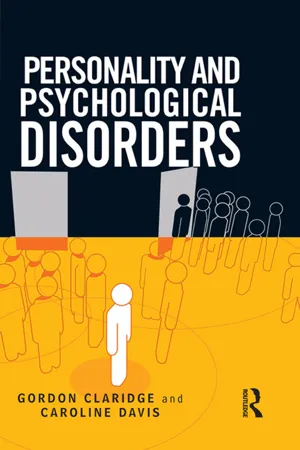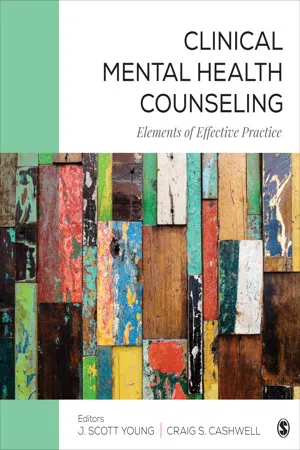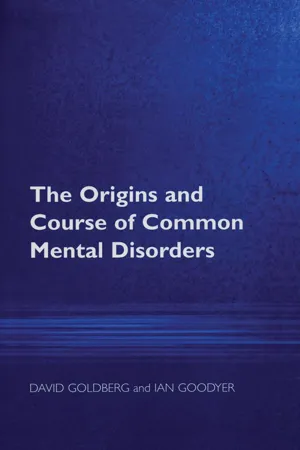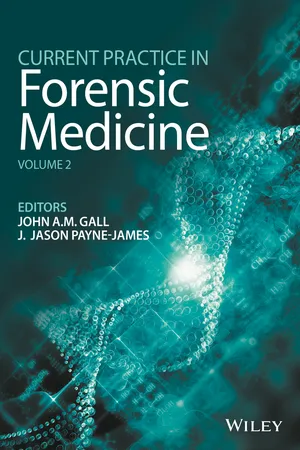Psychology
Categories of Disorders
Categories of disorders in psychology refer to the classification of mental health conditions based on their symptoms and characteristics. These categories help professionals diagnose and treat individuals by providing a framework for understanding and addressing specific issues. Common categories include mood disorders, anxiety disorders, psychotic disorders, and personality disorders.
Written by Perlego with AI-assistance
Related key terms
8 Key excerpts on "Categories of Disorders"
- eBook - ePub
- Naomi Moller, Andreas Vossler, David W Jones, David Kaposi, Naomi Moller, Andreas Vossler, David W Jones, David Kaposi(Authors)
- 2020(Publication Date)
- SAGE Publications Ltd(Publisher)
The DSM continues to have a significant impact on research. Additionally, although the NIMH appears to be distancing itself from the DSM, many other research funding bodies continue to fund studies based on its diagnostic categories. This has an impact on clinical practice: in the UK, the National Institute for Health and Care Excellence publishes clinical guidelines on particular ‘conditions’ which draw on research findings using ICD and DSM categories.Mental health services are increasingly organised by diagnostic categories. The high levels of comorbidity (a medical term used to denote when two or more conditions co-occur) that arise when categories such as those of the DSM are used can create problems; to which service should a person with a diagnosis of both depression and personality disorder be referred, for instance? There is an increasing proliferation of diagnosis-specific adaptations of therapies, such as cognitive behavioural therapy (CBT) for psychosis, CBT for anxiety, and so on. The use of diagnosis by health insurers and the NHS can cause a range of dilemmas. What if a clinician thinks that a person needs help but their problems do not map easily on to diagnostic categories? What if someone does not wish to receive a diagnosis? What if a professional feels that the use of diagnosis is pathologising? How can couple and family therapists record their work using a system that provides categories only for individuals?The debate about DSM-5 has again prompted questions about how we understand mental health and the role of social norms. The reliability problem has returned, while diagnosis has expanded further into everyday life. Rates of diagnosis and medication for some problems have increased. This has led to questions being raised about the influence of the pharmaceutical industry. Diagnostic manuals such as the DSM continue to have an impact on both research and mental health services.Conclusion
Psychiatric diagnosis involves the application of a medical framework to problems in living. By comparing people’s reported problems against the criteria found in diagnostic manuals such as the DSM, the closest-matching diagnostic category or categories can be identified. This chapter has explored whether a medical framework can appropriately be applied to mental health. It has also examined the process of medicalisation, by which problems in living can come to be viewed as mental illnesses. In the case of PTSD, the medicalisation of the condition was welcomed by activists for Vietnam veterans, whereas gay and lesbian activists campaigned to de-medicalise homosexuality and feminists have criticised the inclusion of PMDD in the DSM. - eBook - ePub
Psychology and Social Work
Applied Perspectives
- Gabriela Misca, Peter Unwin(Authors)
- 2017(Publication Date)
- Polity(Publisher)
Classification systems such as the ICD and DSM allow professionals to differentiate types of mental illness and their specific contributory factors in order to provide appropriate treatment. For example, anxiety-related disorders, depression and psychotic disorders have very different aetiologies, and those suffering from them have different needs. However, such classification systems are not free from controversy. These systems have been developed from the medical model and tend to focus on symptoms and define disorders as separate entities, despite the evidence suggesting mental health may be better understood as being a continuum (Larsson et al., 2012). Moreover, by giving diagnostic labels to disorders, there is a risk of inappropriate labelling of a client’s difficulties, and many people are diagnosed with multiple problems, a phenomenon known as comorbidity. The medical model that underpins both the ICD and the DSM places the problem within the individual, a focus on disease and the desire to return the patient to a previous ‘healthy’ state. As mentioned above, the issue of homosexuality has been a subject of great controversy in terms of DSM categorization: it was listed as a disorder until DSM-II, then in DSM-III this ‘diagnosis’ was changed to ‘ego dystonic homosexuality’ (i.e., in conflict with the ego or one’s selfimage). It was only with the publication of the DSM-III-R in 1987 that this was dropped, following a long process of political debate about what constitutes ‘normality’. A social model, as found in counselling psychology and practice, emphasizes health, choice and self-help and would view homosexuality as a matter of choice, not a ‘problem’ that needed solving. - eBook - ePub
- Gordon Claridge, Caroline Davis(Authors)
- 2013(Publication Date)
- Routledge(Publisher)
Chapter 2Description, Classification, and Models of Disorder
The Medical Classification
Whenever natural variations are seen in some phenomenon there is always a need to classify them – to arrive at what in biology is termed a taxonomy, an orderly descriptive system for bringing together subsets of examples that share similar features. In the case of psychological disorders, attempts to construct such a taxonomy – in this case called a nosology – has traditionally been in the hands of psychiatrists. Consequently, as will be evident from our introductory chapter, the form and thinking behind psychiatric nosologies have been very much dictated by a medical model, a belief in the need to identify distinct psychological diseases. This has often attracted criticism. But it should not blind us to the fact that, irrespective of how it is done, som e way of systematically distinguishing between the various psychological disorders is required. Why is this? There are three main reasons.First, it provides clinicians and others involved in the management of the mentally ill with a language in which to communicate with one another about individual cases with whom they are dealing. It obviously helps, when exchanging information about a patient or client, if some commonly agreed terminology is available and if a label can be assigned, which differentiates one person’s disorder from another’s. Second, classification helps in the choice of treatment. Indeed, if it did not do so, the nosology would be of limited use, since one of the main purposes of the labelling process is to match the client to a suitable form of therapy. Third, classification serves a scientific need, by defining the guidelines for studying different types of disorder; it allows researchers interested in a particular disorder to select for investigation only those cases that share defined features of the condition they wish to study. Of course, since such research has to be done in order to help to establish the nosology in the first place, there is an element here of what is often called ‘bootstrapping’, that is, gradually refining the classification on the strength of new knowledge that accumulates from its use. - eBook - ePub
Clinical Mental Health Counseling
Elements of Effective Practice
- J. Scott Young, Craig S. Cashwell(Authors)
- 2016(Publication Date)
- SAGE Publications, Inc(Publisher)
6 DiagnosisGary GintnerLearning Goals
Upon completion of this chapter, you will be able to do the following:- Describe three dimensions of psychopathology
- Describe etiological models of psychopathology, including the biopsychosocial model
- State the major features of the DSM-5
- Apply the four diagnostic principles to a case study to arrive at a diagnosis
Epidemiological studies over the past 20 years have shown that mental disorders are not only common but also are on the rise (Kessler, 2011; Keyes, 2007). In any one year, roughly one in five individuals will have some mental disorder (Kessler et al., 1994; U.S. Public Health Service, 1999). Complicating the problem is the finding that disorders like depression, bipolar disorder, and anxiety disorders are appearing at earlier ages (Keyes, 2007; Keyes & Lopez, 2002). According to the World Health Organization (WHO, 2004a), these prevalence rates are evident worldwide and lead to significant disability burden as indexed by premature death and years of living with a disabling condition. In the United States, only the costs associated with heart disease and physical disabilities exceed the costs associated with mental disorders (Keyes, 2007). These types of statistics highlight the critical role of diagnosis in identifying these conditions in a timely manner so that effective treatments can be rendered.Simply put, diagnosis is the process of determining whether an individual has some maladaptive condition or mental disorder as manifested by a particular set of signs and symptoms (Maxmen, Ward, & Kilgus, 2009). Symptoms are reports of personal experience (e.g., feeling sad or hopeless), whereas signs are observed behaviors (e.g., crying or talking rapidly). A diagnostic classification system lays out the rules and the criteria for making a diagnosis using a particular constellation of these signs and symptoms. The two major classification systems currently in use are the Diagnostic and Statistical Manual of Mental Disorders, 5th edition (DSM-5; American Psychiatric Association [APA], 2013a) and the International Classification of Disease, 10th edition (ICD; WHO, 1992). The primary focus of this chapter is on the DSM-5 - eBook - ePub
DSM-5 Essentials
The Savvy Clinician's Guide to the Changes in Criteria
- Lourie W. Reichenberg(Author)
- 2013(Publication Date)
- Wiley(Publisher)
Chapter 2 THE 20 CLASSIFICATIONS OF DISORDERSFor ease of use, this book follows the same classification of disorders as DSM-5 and, when applicable, notes the name changes in parentheses. When looking for a familiar disorder from DSM-IV that may have been reclassified in DSM-5 , it helps to keep in mind that there is a clear rationale behind the reclassification of some disorders and although the order may seem confusing at first, it reflects data on how disorders are related and tend to cluster together. For example, adjustment disorder has been reclassified as a trauma- and stressor-related disorder in recognition of the fact that exposure to a traumatic or stressful event is an explicit diagnostic criterion for this classification of disorders.To help conceptualize how DSM-5 categorizes disorders, the 20 chapter titles are listed as follows:1. Neurodevelopmental Disorders 2. Schizophrenia Spectrum and Other Psychotic Disorders 3. Bipolar and Related Disorders 4. Depressive Disorders 5. Anxiety Disorders 6. Obsessive-Compulsive and Related Disorders 7. Trauma- and Stressor-Related Disorders 8. Dissociative Disorders 9. Somatic Symptom and Related Disorders 10. Feeding and Eating Disorders 11. Elimination Disorders 12. Sleep-Wake Disorders 13. Sexual Dysfunctions 14. Gender Dysphoria 15. Disruptive, Impulse-Control, and Conduct Disorders 16. Substance-Related and Addictive Disorders 17. Neurocognitive Disorders 18. Personality Disorders 19. Medication-Induced Movement Disorders and Other Adverse Effects of Medication 20. Other Conditions That May Be a Focus of Clinical AttentionWe now turn to an in-depth discussion of each classification area, beginning with a list of disorders preceded by the ICD-9 code for each disorder and followed by the ICD-10 code. After each list is a discussion of the changes from DSM-IV to DSM-5 and the implications for diagnosis. We focus specifically on what has changed from DSM-IV - Prof David Goldberg, Ian M Goodyer(Authors)
- 2014(Publication Date)
- Routledge(Publisher)
Part I The nature and distribution of common mental disordersPassage contains an image
Chapter 1 Competing models for common mental disorders
DOI: 10.4324/9781315820149-1Categorical models of common mental disorders
The conventional taxonomy of mental disorders is that set out in the fifth chapter of the World Health Organisation's International Classification of Disease, tenth edition (WHO 1988 : ICD-10). This is broadly comparable to the fourth edition of the American Psychiatric Association's (1994) Diagnostic and Statistical Manual, fourth edition (DSM-4).These classifications are arrived at by consensus meetings of distinguished psychiatrists, either in Geneva or in Washington. They are essentially arbitrary, ‘top-down’ classifications — and they are necessarily revised at regular intervals, as new treatments become available, as new mental disorders emerge, or as research findings indicate heterogeneity within diagnostic entities.Inevitably, it is easier to reach consensus about major, severe disorders that are worldwide in their distribution — like dementia, mental retardation, schizophrenia and bipolar disorder. It is far more difficult to achieve consensus about the common mental disorders, where cultural factors and differing diagnostic habits dictate different patterns of common symptoms of mental distress.Thus, ‘brain fag’ (Africa), ‘kidney weakness’ (China), ‘Jibyo’ (Japan), ‘burn-out’ (USA), ‘chronic fatigue’ (UK) or ‘neurasthenia’ (Asia) are all ways of referring to syndromes of disordered function in various parts of the world that have no known organic pathology. One solution to this otherwise intractable problem is to impose the diagnostic concepts that have been agreed by senior psychiatrists upon general physicians in the rest of the world. These concepts are heavily influenced by American and European psychiatrists, and may do less than justice to the forms of disorder in other parts of the world.- eBook - ePub
- John A. M. Gall, Jason Payne-James(Authors)
- 2016(Publication Date)
- Wiley-Blackwell(Publisher)
International Classification of Diseases (ICD). The DSM is produced by the American Psychiatric Association and in 2013 the fifth edition was released (DSM‐5: American Psychiatric Association, 2013). The ICD aims to be international in applicability and was produced by the World Health Organization through an iterative process of field trials; the 10th edition is currently in revision, with plans afoot for an 11th edition (ICD‐10: World Health Organization, 1992). There is much discussion about synchronizing the DSM and ICD, although this appears unlikely.Both typologies set out diagnostic criteria by which the diagnosis can be established. These broadly correlate, although minor points of difference mean that a person may satisfy a diagnosis under one diagnostic system but not under the diagnostic criteria under the other. However, in general there is no clear advantage of either diagnostic system over the other. For example, in DSM‐5 (American Psychiatric Association, 1980), a personality disorder is defined as:- An enduring pattern of inner experience and behaviour that deviates markedly from the expectations of the individual's culture. This pattern is manifested in two (or more) of the following areas:
- cognition (i.e., ways of perceiving and interpreting self, other people, and events);
- affectivity (i.e., the range, intensity, lability, and appropriateness of emotional response);
- interpersonal functioning;
- impulse control.
- The enduring pattern is inflexible and pervasive across a broad range of personal and social situations.
- The enduring pattern leads to clinically significant distress or impairment in social, occupational or other important areas of functioning.
- The pattern is stable and of long duration and its onset can be traced back at least to adolescence or early adulthood.
Earlier iterations of the DSM first formally classified personality disorders in the third edition (DSM‐III: American Psychiatric Association, 1980). Personality disorder was assigned to a separate axis or category from clinical disorders, which meant they could be diagnosed in addition to other mental illnesses. In subsequent editions, the approach has remained one of discrete categories. - eBook - ePub
- Jill Peay(Author)
- 2010(Publication Date)
- Routledge-Cavendish(Publisher)
Mental disorderProblems of definition and diagnosis
It would be possible to write an entire book on what is meant by mental disorder. Indeed, an excellent one has already been written on just that topic (Bolton, 2008). Its treatment here will necessarily be partial.Mental disorder has been defined clinically, perhaps tautologically, perhaps simplistically, as ‘a disorder that presents with mental signs and symptoms’. As will emerge more fully in the latter sections of this book, the current legal definitions are hardly more helpful. And there is a further fundamental problem, namely whether mental disorders are indeed distinct from physical disorders. Reputable opinion would argue not (see Kendell, 2001, Matthews, 1999). Indeed Kendell, a former President of the Royal College of Psychiatrists, has argued that… if we do continue to refer to ‘mental’ and ‘physical’ illnesses we should preface both with ‘so-called’, to remind ourselves and our audience that these are archaic and deeply misleading terms. (Kendell, 2001:490)That said, this is not the place to review what is a fascinating literature on the infusion of ‘the mental’ into physical illness and/or vice versa. Rather, the book takes as its premise a widespread recognition of the concept of mental disorder, even if that concept is itself of dubious value.1The focus here is on a tension within the topic between an approach that emphasises a quasi-scientific basis, with all of the seeming certainty that that embraces, and one which places much greater stress on what is not yet known or understood (see Kendell, 2001 and Cheng, 2001, implicitly supporting the scientific view, and Turner, 2003, for a contrary view). The former approach might be typified by frequent resort to the accepted
Learn about this page
Index pages curate the most relevant extracts from our library of academic textbooks. They’ve been created using an in-house natural language model (NLM), each adding context and meaning to key research topics.







